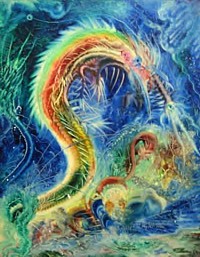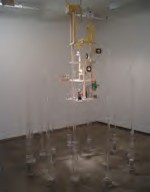
Eugene Von Bruenchenhein, Untitled
The Art District That Ate Manhattan
Checking out the Chelsea Art Guide (a freebie at most galleries), I see that 220 galleries are now listed and black-dotted on the map that tracks them from 12th Avenue to 7th Avenue and from 29th St. to 13th. The densest cluster of numbered dots, however, is still from 26th Street to 20th between 11th and 10th Avenues. Where will it all end? Chelsea: the art district that ate the West Side, that devoured Manhattan?
Lack of decent public transportation was not a hindrance; cabs will go anywhere. And so will art dealers. But it is not just the initial savings on rent or that spaces were not too long ago cheap enough to buy. It is what, for want of another term, might be called the Asian Market Principle.
In the outskirts of New Delhi, all used-tire dealers cluster together; in another area all sari venders. In Tokyo, all the electronic shops are in one neighborhood. In the past, this made no sense to Western sociologists. It seemed exotic and counterintuitive. Wouldn’t it be better to be the only used-tire dealer on your block? But New Yorkers have not forgotten the old Diamond District on 47th Street, the Flower District on 28th St, and the Button District farther north. Similars attract.
Is it that competitors like to keep tabs on each other? Or the altruistic wish to make comparison shopping easier for the consumer? I say it has to do with attracting consumers in search of one particular thing. Even if there happens to be one vendor with better goods or cheaper prices, that’s a plus, because of spillover.
This fall there are more galleries than ever. I count at least 28 additions. Now there’s in-fill, with ground-floor spaces that attempt to look like the garage-conversions pioneered by Barbara Gladstone and a few others.
And the art. We know where it comes from: bad art schools. But where does it go? Storage, I assume. No one ever talks about how much storage and trucking income adds to the economy. Unless art dealers are insane (a few are), some of the art must sell. Although historically art investments do not do as well as the stock market, post-bubble they look like they might.
Chelsea Strategies
Art students usually go to Chelsea on assignment; some of their traditional, stay-at-home suburban moms are now on guided tours; but art-world regulars develop rigid short-lists: Paula Cooper, Gagosian, Barbara Gladstone, Matthew Marks. I myself sift through press releases and announcements to develop my midweek list, more like a battle plan or a Grand Tour itinerary than a to-do list. I write down all the shows I want to see; then rearrange them by block and sometimes by building. If it’s noon, this must be 23rd St. There are some old warehouses that have dozens of galleries: for example, 508-526 W. 26th, 511 West 25, and, with the largest but slowest of elevators of all, 529 W. 20th. The virtues of these three is that they have available WCs on each floor.
Some galleries, based on past experience, are best avoided. Some are iffy or spotty, but can be surprising. And then, as the day wears on, it’s triage, triage.
Here are some recent results…
* * *

Untime Structure, 2004
Julianne Swartz, whose stairwell installation of sound and light-transmitting tubes you may remember from the last Whitney Biennial, debuts with “Speculative Mechanics * persistent optimism” at Josee Bienvenu (529 W. 20th St.. to October 23). This is not really her first solo exhibition, as proclaimed by the press release; a few years back she had an exhibition of shadow pieces at UrbanGlass in Brooklyn. Maybe the press release should have said “her first solo exhibition in Manhattan in a commercial gallery.” But let’s not quibble. There’s press release truth and then there’s truth.
Fresh on the heels of her widely publicized Can You Hear Me? for the New Museum, it’s a splendid show. Can You Hear Me? allowed passersby to communicate to upstairs occupants of a Bowery flophouse through a bright-yellow plastic tube. The new work also uses large plastic tubes, with the exception of a brilliant suspension-by-magnet piece. Otherwise you can look into spiffy white tubes and see yourself or someone else or the room. The newest sculpture, Un-Time Structure, is not as slick, so at first it’s off-putting, but then when you circle it, the twittering sound-producing things in the center begin to make sense: your eyes are a clock. I also liked a small, almost invisible projection that allows you to see the storage room of the gallery, in miniature.
* * *
The New Museum, awaiting its snazzy new downtown building on the Bowery, is temporarily on the ground floor of the Chelsea Museum (556 W. 22nd St). “Adaptive Behavior” is a group show (through Nov. 13) that is supposed to have something to do with this transition. Alas, it reminds me of the notorious, but perhaps more ambitious, New Museum theme shows of the past: dubious topics, dubiously illustrated, pumped up with muddy rhetoric.
Here, 11 artists from five continents are described in the handout as (in the context of the growth of technological networks) “paying close attention to the specific qualities of place and individual behaviors as they are inscribed within this global experience.” But it continues, “And while these artists make use of such networks, their overriding concern is to restore the intimate power of imagery, and of human exchange, even as this is threatened by the ubiquity of those very networks.” Is this a case of “Having your cake and eating it”? Or, although there is yet no catchy term for it, “Any statement can be applied to any artwork”?
I did like, however, in this mélange, Tonico Lemos Auad‘s Untitled (Carpet Antelope), a wall-to-wall carpet with a few figure artfully made of carpet fluff, visibly scratched from the self-same peach (?) colored carpet. Otherwise, the installation favors unfashionable media cacophony.
* * *
Untitled, n.d.
For fans of Outsider Art, a survey of the strange art of Eugene Von Bruenchenheim at Feigen Contemporary (535 W. 20th St., to Oct. 23) is essential. Von Bruenchenheim worked at a Milwaukee bakery during the day and on his art at night. When he died in 1983 at 73, a stash of his extraterrestrial “finger-paintings,” sculptures made of chicken bones, and “cutie-girl” photographs of his muse Eveline “Marie” Kalke came to light. Some parts of his feathery paintings were manipulated with brushes made from Marie’s hair. Actually, even for those not acquainted with the art genre of the untrained and the visionary, there is enough unconscious surrealism — now that’s a fine phrase — to please or provoke.
* * *

“Forever” Bicycles, n.d.
Ai Weiwei is by all accounts a mover and shaker in new Chinese art. He was part of the Stars Group that rejected Chinese propaganda art in 1973. After that he attended art schools in New York, living in the East Village for 12 years. Armed with Duchampian and Warholian strategies, he went back to Beijing in 1993.
Chelsea is full of surprises. It’s the Robert Miller Gallery (524 W. 26th St., to Oct. 9), not known for the avant-garde, and not Gagosian or Cooper that’s presenting an inspired survey of Weiwei’s work. A gigantic chandelier nearly fills one of the small front rooms from ceiling to floor, emitting heat and seemingly sucking the air out of the room. The centerpiece is “Forever” Bicycles, a large cylinder of 42 conjoined Forever brand Chinese bicycles. A while back, I thought I might have an opportunity to go to Beijing, so I rented every contemporary Chinese movie set in Beijing I could find. Bicycles, bicycles. Even special traffic lights just for bicycles. What we don’t know if bicycles symbolize ecology or a new definition of poverty, the latter I suppose.
I also particularly liked Weiwei’s iron and wood Bench Map of China. Only when you look at the sides do you realize that the cross-section ends of the rippled mass reveal the map of China. Other pieces, such as documentation of dropping a Han Dynasty urn and photos of giving the finger to various tourist sites seem merely naughty.
